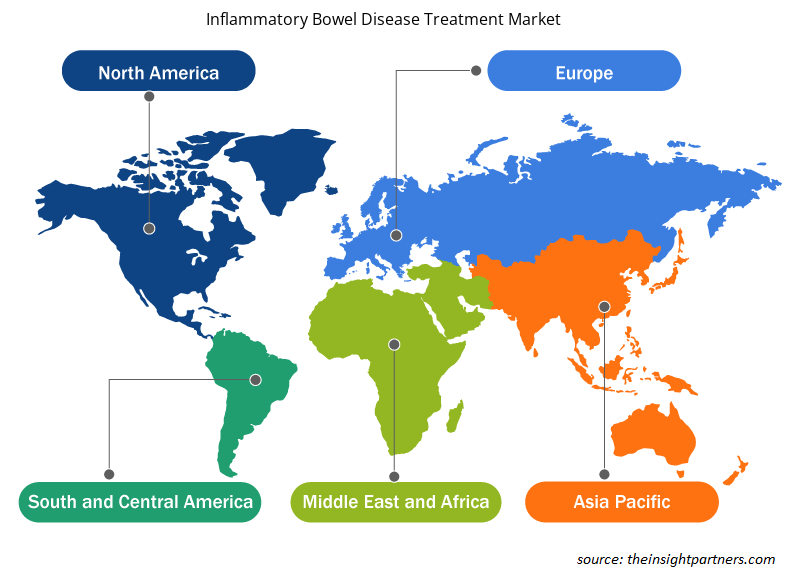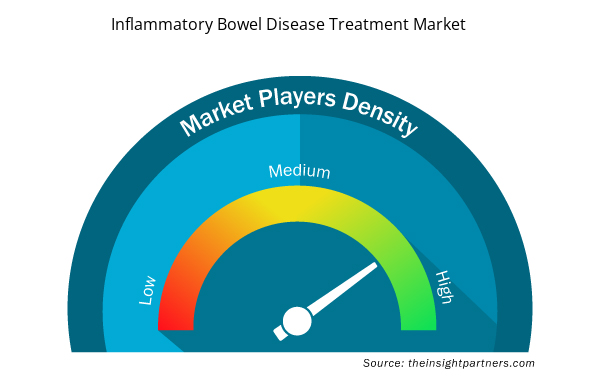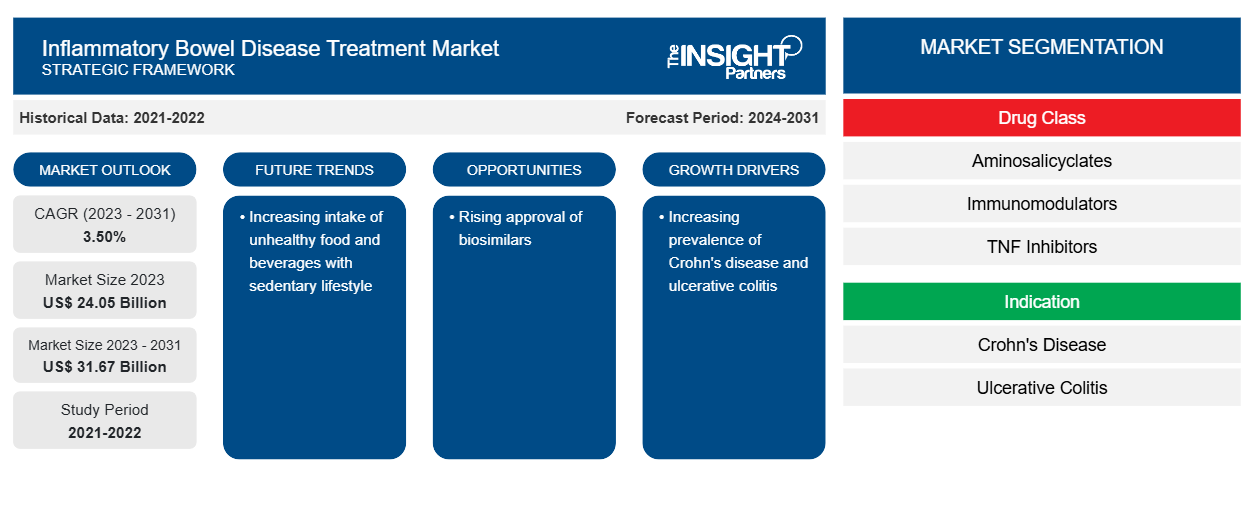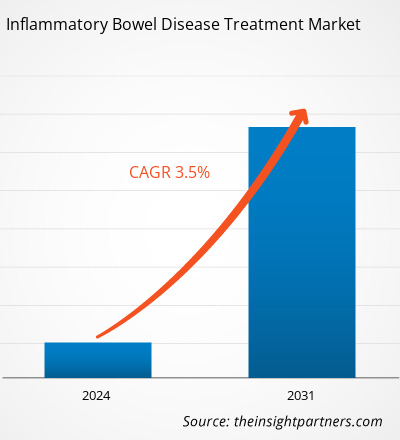Si prevede che il valore del mercato dei trattamenti per le malattie infiammatorie intestinali crescerà da 24,05 miliardi di dollari nel 2023 a 31,67 miliardi di dollari entro il 2031; si prevede che il mercato registrerà un CAGR del 3,50% dal 2023 al 2031.
Approfondimenti di mercato e opinioni degli analisti:
La malattia infiammatoria intestinale (IBD) è una condizione infiammatoria cronica del tratto gastrointestinale, tra cui il morbo di Crohn e la colite ulcerosa. Queste condizioni causano infiammazione del rivestimento del tratto digerente, portando a sintomi come dolore addominale, diarrea, affaticamento e perdita di peso. Il trattamento mira a ridurre l'infiammazione, gestire i sintomi e prevenire le complicazioni tramite farmaci, cambiamenti nello stile di vita e talvolta interventi chirurgici. La gestione dell'IBD richiede in genere cure mediche e monitoraggio continui per mantenere la remissione e migliorare la qualità della vita. I fattori chiave che guidano la crescita del mercato del trattamento della malattia infiammatoria intestinale sono la crescente prevalenza del morbo di Crohn e della colite ulcerosa e il crescente numero di lanci di prodotti. Questo rapporto include prospettive di crescita dovute alle attuali tendenze del mercato del trattamento della malattia infiammatoria intestinale e al loro impatto prevedibile durante il periodo di previsione. È probabile che i progressi tecnologici portino tendenze significative nel mercato del trattamento della malattia infiammatoria intestinale nei prossimi anni. Inoltre, si prevede che anche lo sviluppo di trattamenti innovativi attraverso la ricerca continua e l'incoraggiamento di iniziative governative alimenteranno la crescita del mercato.
Fattori di crescita e sfide:
Il morbo di Crohn è un disturbo cronico complesso che colpisce principalmente l'apparato digerente. La National Library of Medicine ha dichiarato che nel 2023 si sono verificati 825 casi di IBD ogni 100.000 persone, rispetto ai 410 casi di morbo di Crohn e ai 414 casi di colite ulcerosa e IBD-u. Con una prevalenza dello 0,82%, 322.600 canadesi hanno avuto IBD nel 2023. I pazienti con malattie gastrointestinali sono a maggior rischio di deterioramento nutrizionale a causa dei requisiti di digiuno dei test diagnostici, delle restrizioni dietetiche terapeutiche e della perdita di appetito dovuta all'anoressia o ai requisiti nutrizionali alterati causati dalla malattia stessa. Pertanto, la nutrizione enterale è prescritta ai pazienti con malattie gastrointestinali, poiché la via enterale è preferita per fornire i nutrienti necessari. Pertanto, la crescente prevalenza del morbo di Crohn e della colite ulcerosa guida la crescita del mercato del trattamento delle malattie infiammatorie intestinali.
Malattia di Crohn, malattia gastrointestinale dovuta a trauma, ostruzione intestinale (BO), colite microscopica, sindrome dell'intestino corto e colite ulcerosa sono alcune delle malattie gastrointestinali più comuni. Secondo un articolo pubblicato su Healthline nel 2021, circa il 40% delle persone in tutto il mondo è affetto da disturbi gastrointestinali funzionali. La Canadian Digestive Health Foundation afferma che milioni di canadesi convivono con malattie digestive; circa 20 milioni di canadesi, ovvero 2 persone su 3, soffrono di disturbi digestivi ogni anno.
D'altro canto, l'elevato costo associato al trattamento della malattia infiammatoria intestinale (IBD) rappresenta un ostacolo significativo nel mercato dei trattamenti per l'IBD. Dai farmaci costosi ai frequenti ricoveri ospedalieri e interventi chirurgici, la gestione dell'IBD può rappresentare un pesante onere finanziario per i pazienti e i sistemi sanitari. Il fattore costo spesso limita l'accesso a cure ottimali e trattamenti innovativi per molte persone affette da IBD. Affrontare i problemi di convenienza e accessibilità è fondamentale per migliorare i risultati e la qualità della vita dei pazienti affetti da questa condizione cronica. Pertanto, l'elevato costo associato al trattamento ostacola la crescita del mercato dei trattamenti per la malattia infiammatoria intestinale.
Personalizza questo report in base alle tue esigenze
Riceverai la personalizzazione gratuita di qualsiasi report, comprese parti di questo report, o analisi a livello nazionale, pacchetto dati Excel, oltre a usufruire di grandi offerte e sconti per start-up e università
- Scopri le principali tendenze di mercato in questo rapporto.Questo campione GRATUITO includerà analisi di dati che spaziano dalle tendenze di mercato alle stime e alle previsioni.
Segmentazione e ambito del report:
L'analisi del mercato del trattamento delle malattie infiammatorie intestinali è stata condotta considerando i seguenti segmenti: classe di farmaci, indicazione della malattia e canale di distribuzione. In base alla geografia, il mercato del trattamento delle malattie infiammatorie intestinali è segmentato in Nord America (Stati Uniti, Canada e Messico), Europa (Regno Unito, Germania, Francia, Italia, Spagna e resto d'Europa), Asia Pacifico (Cina, Giappone, India, Australia, Corea del Sud e resto dell'Asia Pacifico), Medio Oriente e Africa (Emirati Arabi Uniti, Arabia Saudita, Sud Africa e resto del Medio Oriente e Africa) e Sud e Centro America (Brasile, Argentina e resto del Sud e Centro America).
Analisi segmentale:
Approfondimenti basati sulla classe di farmaci
In base alla classe di farmaci, il mercato è segmentato in biologici, aminosalicilati, corticosteroidi e altri. Il segmento dei biologici ha detenuto la quota di mercato più grande nel trattamento delle malattie infiammatorie intestinali nel 2023 e si prevede che registrerà il CAGR più elevato nel periodo 2023-2031.
Approfondimenti basati sulle indicazioni della malattia
In base all'indicazione della malattia, il mercato del trattamento delle malattie infiammatorie intestinali è diviso in morbo di Crohn e colite ulcerosa. Si prevede che il segmento del morbo di Crohn detenga una quota di mercato significativa entro il 2031.
Approfondimenti basati sulle indicazioni della malattia
In base al canale di distribuzione, il mercato è classificato in farmacia ospedaliera, farmacia al dettaglio e farmacia online. Si prevede che il segmento della farmacia ospedaliera detiene una quota significativa del mercato del trattamento delle malattie infiammatorie intestinali entro il 2031.
Approfondimenti regionali sul mercato del trattamento delle malattie infiammatorie intestinali
Le tendenze regionali e i fattori che influenzano il mercato del trattamento delle malattie infiammatorie intestinali durante il periodo di previsione sono stati ampiamente spiegati dagli analisti di Insight Partners. Questa sezione discute anche i segmenti del mercato del trattamento delle malattie infiammatorie intestinali e la geografia in Nord America, Europa, Asia Pacifico, Medio Oriente e Africa e America meridionale e centrale.

- Ottieni i dati specifici regionali per il mercato del trattamento delle malattie infiammatorie intestinali
Ambito del rapporto di mercato sul trattamento delle malattie infiammatorie intestinali
| Attributo del report | Dettagli |
|---|---|
| Dimensioni del mercato nel 2023 | 24,05 miliardi di dollari USA |
| Dimensioni del mercato entro il 2031 | 31,67 miliardi di dollari USA |
| CAGR globale (2023-2031) | 3,50% |
| Dati storici | 2021-2022 |
| Periodo di previsione | 2024-2031 |
| Segmenti coperti | Per classe di farmaci
|
| Regioni e Paesi coperti | America del Nord
|
| Leader di mercato e profili aziendali chiave |
|
Densità degli operatori del mercato del trattamento delle malattie infiammatorie intestinali: comprendere il suo impatto sulle dinamiche aziendali
Il mercato del trattamento delle malattie infiammatorie intestinali sta crescendo rapidamente, spinto dalla crescente domanda degli utenti finali dovuta a fattori quali l'evoluzione delle preferenze dei consumatori, i progressi tecnologici e una maggiore consapevolezza dei benefici del prodotto. Con l'aumento della domanda, le aziende stanno ampliando le loro offerte, innovando per soddisfare le esigenze dei consumatori e capitalizzando sulle tendenze emergenti, il che alimenta ulteriormente la crescita del mercato.
La densità degli operatori di mercato si riferisce alla distribuzione di aziende o società che operano in un particolare mercato o settore. Indica quanti concorrenti (operatori di mercato) sono presenti in un dato spazio di mercato in relazione alle sue dimensioni o al valore di mercato totale.
Le principali aziende che operano nel mercato del trattamento delle malattie infiammatorie intestinali sono:
- Pfizer, Inc.,
- Novartis AG,
- AbbVie, Inc.,
- Takeda Pharmaceuticals, Johnson e Johnson
- , Celegene Corporation,
- Aziende sanitarie Bausch
Disclaimer : le aziende elencate sopra non sono classificate secondo un ordine particolare.

- Ottieni una panoramica dei principali attori del mercato del trattamento delle malattie infiammatorie intestinali
Analisi regionale:
L'ambito geografico del rapporto sul mercato del trattamento delle malattie infiammatorie intestinali comprende Nord America, Europa, Asia Pacifico, Medio Oriente e Africa e Sud e Centro America. Nel 2023, il Nord America deteneva la quota di mercato maggiore. Gli Stati Uniti dominano il mercato in Nord America con la quota di fatturato maggiore. L'espansione delle dimensioni del mercato del trattamento delle malattie infiammatorie intestinali in questo paese è attribuita a un aumento della prevalenza di malattie infiammatorie, alla presenza di importanti attori del mercato e alle loro iniziative strategiche. Soluzioni di pagamento migliorate, alti tassi di trattamento, crescente prescrizione di farmaci innovativi, ininterrotti sforzi di ricerca e iniziative governative favorevoli avvantaggiano anche il mercato del trattamento delle malattie infiammatorie intestinali negli Stati Uniti e in altri paesi del Nord America. La Crohn's & Colitis Foundation è una delle organizzazioni degne di nota dedicate alla promozione della ricerca clinica e traslazionale volta a curare la colite e il morbo di Crohn.
Scenario competitivo e aziende chiave:
Le previsioni di mercato per il trattamento delle malattie infiammatorie intestinali presentate in questo rapporto possono aiutare gli stakeholder di questo mercato a pianificare le loro strategie di crescita. AbbVie Inc, Takeda Pharmaceutical Company Limited, Pfizer Inc, Biogen, Novartis AG, Lilly, UCB SA, CELLTRION INC., Merck & Co., Inc. e Johnson & Johnson Services, Inc. sono alcune delle aziende chiave descritte nel rapporto sul trattamento delle malattie infiammatorie intestinali. Queste aziende si concentrano sull'espansione delle loro offerte per soddisfare la crescente domanda dei consumatori in tutto il mondo. La loro presenza globale consente loro di servire molti clienti, consentendo loro di espandere la loro presenza sul mercato.
- Analisi storica (2 anni), anno base, previsione (7 anni) con CAGR
- Analisi PEST e SWOT
- Valore/volume delle dimensioni del mercato - Globale, regionale, nazionale
- Industria e panorama competitivo
- Set di dati Excel


- Medical Collagen Market
- Emergency Department Information System (EDIS) Market
- Single-Use Negative Pressure Wound Therapy Devices Market
- Fishing Equipment Market
- Mail Order Pharmacy Market
- Identity Verification Market
- Electronic Toll Collection System Market
- Visualization and 3D Rendering Software Market
- Vessel Monitoring System Market
- Aesthetic Medical Devices Market

Report Coverage
Revenue forecast, Company Analysis, Industry landscape, Growth factors, and Trends

Segment Covered
This text is related
to segments covered.

Regional Scope
North America, Europe, Asia Pacific, Middle East & Africa, South & Central America

Country Scope
This text is related
to country scope.
Domande frequenti
Based on drug class, the market is segmented into biologics, aminosalicyclates, corticosteroids, and others. The biologics segment held the largest Inflammatory Bowel Disease Treatment Market share in 2023 and is anticipated to register the highest CAGR during 2023–2031.
Based on disease indication, the Inflammatory Bowel Disease Treatment Market is segmented into crohn's disease and ulcerative colitis. The crohn's disease segment is anticipated to hold a significant share by 2031.
The Inflammatory Bowel Disease Treatment Market was valued at US$ 24.05 billion in 2023.
The Inflammatory Bowel Disease Treatment Market is expected to be valued at US$ 31.67 billion in 2031.
The Inflammatory Bowel Disease Treatment Market has major market players, including AbbVie Inc, Takeda Pharmaceutical Company Limited, Pfizer Inc, Biogen, Novartis AG, Lilly, UCB S.A., CELLTRION INC., Merck & Co., Inc., and Johnson & Johnson Services, Inc.
The key factors driving the Inflammatory Bowel Disease Treatment Market growth are the rising prevalence of crohn's disease and ulcerative colitis and increasing product launches over the projection period. Inflammatory Bowel Disease Treatment Market trends include the technological advancement in IBD treatment. Furthermore, the development of innovative treatments through continuing research as well as encouraging government initiatives are also expected to fuel the market growth.
Inflammatory bowel disease" (IBD) is a chronic inflammatory condition of the gastrointestinal tract, including Crohn's disease and ulcerative colitis. These conditions cause inflammation of the digestive tract lining, leading to symptoms like abdominal pain, diarrhea, fatigue, and weight loss. Treatment aims to reduce inflammation, manage symptoms, and prevent complications through medication, lifestyle changes, and sometimes surgery. Managing IBD typically requires ongoing medical care and monitoring to maintain remission and improve quality of life.
Trends and growth analysis reports related to Life Sciences : READ MORE..
The List of Companies - Inflammatory Bowel Disease Treatment Market
- AbbVie Inc
- Takeda Pharmaceutical Company Limited
- Pfizer Inc
- Biogen
- Novartis AG
- Lilly
- UCB S.A.
- CELLTRION INC.
- Merck & Co., Inc.
- Johnson & Johnson Services, Inc.
- Mindray Medical International Limited
The Insight Partners performs research in 4 major stages: Data Collection & Secondary Research, Primary Research, Data Analysis and Data Triangulation & Final Review.
- Data Collection and Secondary Research:
As a market research and consulting firm operating from a decade, we have published and advised several client across the globe. First step for any study will start with an assessment of currently available data and insights from existing reports. Further, historical and current market information is collected from Investor Presentations, Annual Reports, SEC Filings, etc., and other information related to company’s performance and market positioning are gathered from Paid Databases (Factiva, Hoovers, and Reuters) and various other publications available in public domain.
Several associations trade associates, technical forums, institutes, societies and organization are accessed to gain technical as well as market related insights through their publications such as research papers, blogs and press releases related to the studies are referred to get cues about the market. Further, white papers, journals, magazines, and other news articles published in last 3 years are scrutinized and analyzed to understand the current market trends.
- Primary Research:
The primarily interview analysis comprise of data obtained from industry participants interview and answers to survey questions gathered by in-house primary team.
For primary research, interviews are conducted with industry experts/CEOs/Marketing Managers/VPs/Subject Matter Experts from both demand and supply side to get a 360-degree view of the market. The primary team conducts several interviews based on the complexity of the markets to understand the various market trends and dynamics which makes research more credible and precise.
A typical research interview fulfils the following functions:
- Provides first-hand information on the market size, market trends, growth trends, competitive landscape, and outlook
- Validates and strengthens in-house secondary research findings
- Develops the analysis team’s expertise and market understanding
Primary research involves email interactions and telephone interviews for each market, category, segment, and sub-segment across geographies. The participants who typically take part in such a process include, but are not limited to:
- Industry participants: VPs, business development managers, market intelligence managers and national sales managers
- Outside experts: Valuation experts, research analysts and key opinion leaders specializing in the electronics and semiconductor industry.
Below is the breakup of our primary respondents by company, designation, and region:

Once we receive the confirmation from primary research sources or primary respondents, we finalize the base year market estimation and forecast the data as per the macroeconomic and microeconomic factors assessed during data collection.
- Data Analysis:
Once data is validated through both secondary as well as primary respondents, we finalize the market estimations by hypothesis formulation and factor analysis at regional and country level.
- Macro-Economic Factor Analysis:
We analyse macroeconomic indicators such the gross domestic product (GDP), increase in the demand for goods and services across industries, technological advancement, regional economic growth, governmental policies, the influence of COVID-19, PEST analysis, and other aspects. This analysis aids in setting benchmarks for various nations/regions and approximating market splits. Additionally, the general trend of the aforementioned components aid in determining the market's development possibilities.
- Country Level Data:
Various factors that are especially aligned to the country are taken into account to determine the market size for a certain area and country, including the presence of vendors, such as headquarters and offices, the country's GDP, demand patterns, and industry growth. To comprehend the market dynamics for the nation, a number of growth variables, inhibitors, application areas, and current market trends are researched. The aforementioned elements aid in determining the country's overall market's growth potential.
- Company Profile:
The “Table of Contents” is formulated by listing and analyzing more than 25 - 30 companies operating in the market ecosystem across geographies. However, we profile only 10 companies as a standard practice in our syndicate reports. These 10 companies comprise leading, emerging, and regional players. Nonetheless, our analysis is not restricted to the 10 listed companies, we also analyze other companies present in the market to develop a holistic view and understand the prevailing trends. The “Company Profiles” section in the report covers key facts, business description, products & services, financial information, SWOT analysis, and key developments. The financial information presented is extracted from the annual reports and official documents of the publicly listed companies. Upon collecting the information for the sections of respective companies, we verify them via various primary sources and then compile the data in respective company profiles. The company level information helps us in deriving the base number as well as in forecasting the market size.
- Developing Base Number:
Aggregation of sales statistics (2020-2022) and macro-economic factor, and other secondary and primary research insights are utilized to arrive at base number and related market shares for 2022. The data gaps are identified in this step and relevant market data is analyzed, collected from paid primary interviews or databases. On finalizing the base year market size, forecasts are developed on the basis of macro-economic, industry and market growth factors and company level analysis.
- Data Triangulation and Final Review:
The market findings and base year market size calculations are validated from supply as well as demand side. Demand side validations are based on macro-economic factor analysis and benchmarks for respective regions and countries. In case of supply side validations, revenues of major companies are estimated (in case not available) based on industry benchmark, approximate number of employees, product portfolio, and primary interviews revenues are gathered. Further revenue from target product/service segment is assessed to avoid overshooting of market statistics. In case of heavy deviations between supply and demand side values, all thes steps are repeated to achieve synchronization.
We follow an iterative model, wherein we share our research findings with Subject Matter Experts (SME’s) and Key Opinion Leaders (KOLs) until consensus view of the market is not formulated – this model negates any drastic deviation in the opinions of experts. Only validated and universally acceptable research findings are quoted in our reports.
We have important check points that we use to validate our research findings – which we call – data triangulation, where we validate the information, we generate from secondary sources with primary interviews and then we re-validate with our internal data bases and Subject matter experts. This comprehensive model enables us to deliver high quality, reliable data in shortest possible time.


 Ottieni un campione gratuito per questo repot
Ottieni un campione gratuito per questo repot